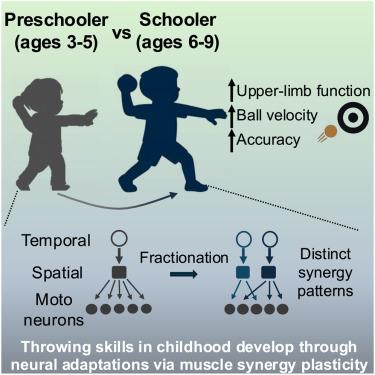Developmental changes in upper limb muscle synergies during throwing: A comparison between preschoolers and schoolers
IF 4.1
2区 综合性期刊
Q1 MULTIDISCIPLINARY SCIENCES
引用次数: 0
Abstract
Throwing is a fundamental motor behavior that undergoes marked refinement during childhood, yet the neuromuscular mechanisms underlying this process remain unclear. We compared upper limb muscle synergies in preschool-aged (3–5 years; n = 13) and school-aged (6–9 years; n = 8) children during overarm throwing. Participants threw balls toward a fixed target while electromyographic activity from 16 upper limb muscles and ball kinematics were recorded. Muscle synergies, extracted using non-negative matrix factorization, were analyzed for structure and sparseness. School-aged children exhibited higher ball velocity, improved accuracy, and greater synergy sparseness, reflecting more selective muscle recruitment. Cluster analysis identified eight synergy clusters in schoolers versus six in preschoolers, with several preschooler synergies fractionated into functionally specialized components in schoolers. These refinements—across the upper limb—likely enhance energy transfer efficiency and release control. The findings highlight fractionation-driven specialization as a key developmental adaptation that supports improved throwing performance.

投掷运动中上肢肌肉协同作用的发展变化:学龄前儿童与学龄儿童的比较
投掷是一种基本的运动行为,在儿童时期经历了显著的改进,但这一过程背后的神经肌肉机制尚不清楚。我们比较了学龄前儿童(3-5岁,n = 13)和学龄儿童(6-9岁,n = 8)的上肢肌肉协同作用。参与者向固定目标投掷球,同时记录16块上肢肌肉的肌电图活动和球的运动学。利用非负矩阵分解提取肌肉协同效应,分析其结构和稀疏性。学龄儿童表现出更高的球速、更高的准确性和更大的协同稀疏性,反映出更多的选择性肌肉招募。聚类分析确定了学龄期儿童有8个协同集群,而学龄前儿童有6个协同集群,学龄前儿童中有几个协同集群被划分为功能专门的组件。这些改进——跨越上肢——可能会提高能量传递效率和释放控制。研究结果强调,分馏驱动的专业化是支持提高投掷成绩的关键发展适应。
本文章由计算机程序翻译,如有差异,请以英文原文为准。
求助全文
约1分钟内获得全文
求助全文
来源期刊

iScience
Multidisciplinary-Multidisciplinary
CiteScore
7.20
自引率
1.70%
发文量
1972
审稿时长
6 weeks
期刊介绍:
Science has many big remaining questions. To address them, we will need to work collaboratively and across disciplines. The goal of iScience is to help fuel that type of interdisciplinary thinking. iScience is a new open-access journal from Cell Press that provides a platform for original research in the life, physical, and earth sciences. The primary criterion for publication in iScience is a significant contribution to a relevant field combined with robust results and underlying methodology. The advances appearing in iScience include both fundamental and applied investigations across this interdisciplinary range of topic areas. To support transparency in scientific investigation, we are happy to consider replication studies and papers that describe negative results.
We know you want your work to be published quickly and to be widely visible within your community and beyond. With the strong international reputation of Cell Press behind it, publication in iScience will help your work garner the attention and recognition it merits. Like all Cell Press journals, iScience prioritizes rapid publication. Our editorial team pays special attention to high-quality author service and to efficient, clear-cut decisions based on the information available within the manuscript. iScience taps into the expertise across Cell Press journals and selected partners to inform our editorial decisions and help publish your science in a timely and seamless way.
 求助内容:
求助内容: 应助结果提醒方式:
应助结果提醒方式:


